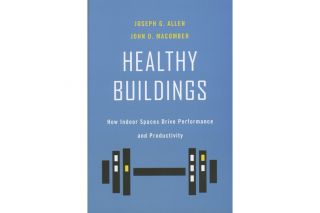
www.buildingsandcities.org/insights/reviews/architecture-natural-cooling.html
The Architecture of Natural Cooling

By Brian Ford, Rosa Schiano-Phan and Juan Vallejo Routledge, 2020, ISBN: 9781138629073
Building scientist, troubleshooter
and policy adviser Bill Bordass reviews this book.
The UN and many other bodies have declared a climate emergency. Lower-energy buildings - both new and existing - will play an important part in tackling this, making good use of natural and passive cooling and ventilation systems to the extent possible, as part of an integrated design strategy. This makes the book very welcome: it covers the principles of natural cooling, calculation methods, practical details, and includes findings from case studies
The book is clear, well-written, well-structured, and contains much good information, advice, guidance and experience. It will appeal to practitioners - planners, architects and engineers - and to students. The authors are well-regarded architects and academics, who designed some of the buildings they write about. Unusually, they also examine how well the systems worked in operation, what went wrong, and what was or might be done to improve their performance.
The book starts with a short historic introduction, reminding readers how much we forgot about passive design in the age of cheap fuel. A long chapter on principles follows: how to analyse the site and its microclimate, and showing the range of natural cooling strategies available - from simple window ventilation to the updraught and downdraught cooling systems that inform the authors' distinctive buildings. Chapter 3 illustrates clearly which passive cooling strategies are most likely to suit particular climates, illustrating these in maps of different parts of the world.
Chapter 4 shows how these ingredients can be brought together to produce integrated designs for new buildings and for retrofits with improved natural cooling. The morphology of some cities is reviewed, identifying features like courtyards and light wells that might be adapted to increase the natural cooling available. Chapter 5 introduces simple calculation methods, helping designers to come to grips with the requirements, the types of natural ventilation and cooling system that might suit, and how big they need to be. Chapter 6 shows how to test the performance of promising solutions in more detail. Chapter 7 covers the components required to realise the chosen strategy, how to select them, and pitfalls to be avoided.
The book includes many illustrations of buildings in which these principles have been applied. It finishes with six case studies; three from the US, one each from India and China, and the conversion into offices of a 19th Century historic church in Malta. All make use of downdraught cooling, mostly evaporative but sometimes with naturally-aspirated cooling coils also available for particular seasons, using chilled and/or naturally cooled water. The downdraught stacks in some buildings are reversible, e.g. to provide natural buoyancy ventilation on cool summer nights.
The case studies showed that:
- Well-designed naturally-cooled buildings can work well, if the design is well-considered, integrated and executed. They often use much less energy than with mechanical cooling.
- Occupant satisfaction in the Indian and Chinese buildings was good. In the US, occupants were more critical, perhaps revealing higher expectations. As Amory Lovins of the Rocky Mountain Institute once said, air-conditioning can be addictive. Indeed, it was added in the offices of one of the American case studies, although better cross-ventilation and solar control might have sufficed.
- Air flows were not always as intended, for example being disrupted by certain winds, or by closed doors. Predicted natural buoyancy "stack" effects did not always occur. Ventilation and security requirements sometimes clashed: an all-too-common experience.
- Evaporative cooling systems could be challenging to adjust and maintain, and in one case study the evaporative mode was abandoned. Atomising nozzles using compressed air worked best, while pressurised water nozzles could be noisy and sometimes drip and stream. Wetted pads needed more care, used more water, and obstructed air flow, which also made it more difficult to use the same shaft for different purposes.
- Water could end up in the wrong place - not just at the bottom of the tower, but carrying over into occupied spaces.
Some other findings apply equally to conventional buildings:
- The importance of tuning-up the technical systems and controls after handover, which seldom happens anywhere.
- Good operation and maintenance thereafter: in one building, cobwebs inhibited the airflow.
- The need for a knowledgeable on-site building manager. While domestic systems can be designed for the occupier to look after, the more diverse spaces and user requirements in larger buildings require someone to take an overview.
- Some buildings were designed to operate in different modes according to the weather and time of day. Their automatic controls and Building Management Systems did not always work well and could be baffling. Some reverted to manual operation, but this could create other problems, e.g. operating in the wrong mode for the weather and causing condensation.
- In some case studies, occupants reported a lack of personal control - a common problem.
The authors conclude that simpler can work better, in both strategy and delivery: hybrid systems and deeper plan forms were a challenge for both procurement and management. In my experience, it can be particularly difficult to commission systems that blend natural, mechanical and electrical components. The industry is not used to doing it, responsibilities fall through gaps between different skills, and tuning cannot take place in real time, but needs an extended period.
In common with many buildings, most of the case studies ended up with higher occupancy and more equipment than anticipated, increasing the risk of overheating. The authors therefore encourage designers not to miss any tricks: some of the buildings could have had better solar control, more thermal capacity, and closer scrutiny of air paths, particularly for cross-ventilation. For future resilience in a warming climate, prevention is better than cure!
The book's clear and succinct coverage of the subject is to be applauded. While the principles are universal, its case studies concentrate on buildings in warmer climates, all using evaporative downdraught cooling to some extent. I would have liked to have seen some studies of simpler solutions for milder climates too. In the UK, many new dwellings overheat: often exacerbated by poor window design, unnecessary heat gains from building services systems, and seemingly wilful ignorance of the principles of natural cooling that are so well described in this book.
Latest Peer-Reviewed Journal Content
Net zero retrofit of the building stock [editorial]
D Godoy-Shimizu & P Steadman
Co-learning in living labs: nurturing civic agency and resilience
A Belfield
The importance of multi-roles and code-switching in living labs
H Noller & A Tarik
Researchers’ shifting roles in living labs for knowledge co-production
C-C Dobre & G Faldi
Increasing civic resilience in urban living labs: city authorities’ roles
E Alatalo, M Laine & M Kyrönviita
Co-curation as civic practice in community engagement
Z Li, M Sunikka-Blank, R Purohit & F Samuel
Preserving buildings: emission reductions from circular economy strategies in Austria
N Alaux, V Kulmer, J Vogel & A Passer
Urban living labs: relationality between institutions and local circularity
P Palo, M Adelfio, J Lundin & E Brandão
Living labs: epistemic modelling, temporariness and land value
J Clossick, T Khonsari & U Steven
Co-creating interventions to prevent mosquito-borne disease transmission in hospitals
O Sloan Wood, E Lupenza, D M Agnello, J B Knudsen, M Msellem, K L Schiøler & F Saleh
Circularity at the neighbourhood scale: co-creative living lab lessons
J Honsa, A Versele, T Van de Kerckhove & C Piccardo
Positive energy districts and energy communities: how living labs create value
E Malakhatka, O Shafqat, A Sandoff & L Thuvander
Built environment governance and professionalism: the end of laissez-faire (again)
S Foxell
Co-creating justice in housing energy transitions through energy living labs
D Ricci, C Leiwakabessy, S van Wieringen, P de Koning & T Konstantinou
HVAC characterisation of existing Canadian buildings for decarbonisation retrofit identification
J Adebisi & J J McArthur
Simulation and the building performance gap [editorial]
M Donn
Developing criteria for effective building-sector commitments in nationally determined contributions
P Graham, K McFarlane & M Taheri
Reimagining circularity: actions for optimising the use of existing buildings
R Lundgren, R Kyrö, S Toivonen & L Tähtinen
Effective interdisciplinary stakeholder engagement in net zero building design
S Vakeva-Baird, F Tahmasebi, JJ Williams & D Mumovic
Metrics for building component disassembly potential: a practical framework
H Järvelä, A Lehto, T Pirilä & M Kuittinen
The unfitness of dwellings: why spatial and conceptual boundaries matter
E Nisonen, D Milián Bernal & S Pelsmakers
Environmental variables and air quality: implications for planning and public health
H Itzhak-Ben-Shalom, T Saroglou, V Multanen, A Vanunu, A Karnieli, D Katoshevski, N Davidovitch & I A Meir
Exploring diverse drivers behind hybrid heating solutions
S Kilpeläinen, S Pelsmakers, R Castaño-Rosa & M-S Miettinen
Urban rooms and the expanded ecology of urban living labs
E Akbil & C Butterworth
Living with extreme heat: perceptions and experiences
L King & C Demski
A systemic decision-making model for energy retrofits
C Schünemann, M Dshemuchadse & S Scherbaum
Modelling site-specific outdoor temperature for buildings in urban environments
K Cebrat, J Narożny, M Baborska-Narożny & M Smektała
Understanding shading through home-use experience, measurement and modelling
M Baborska-Narożny, K Bandurski, & M Grudzińska
Building performance simulation for sensemaking in architectural pedagogy
M Bohm
Beyond the building: governance challenges in social housing retrofit
H Charles
Heat stress in social housing districts: tree cover–built form interaction
C Lopez-Ordoñez, E Garcia-Nevado, H Coch & M Morganti
An observational analysis of shade-related pedestrian activity
M Levenson, D Pearlmutter & O Aleksandrowicz
Learning to sail a building: a people-first approach to retrofit
B Bordass, R Pender, K Steele & A Graham
Market transformations: gas conversion as a blueprint for net zero retrofit
A Gillich
Resistance against zero-emission neighbourhood infrastructuring: key lessons from Norway
T Berker & R Woods
Megatrends and weak signals shaping future real estate
S Toivonen
A strategic niche management framework to scale deep energy retrofits
T H King & M Jemtrud
Generative AI: reconfiguring supervision and doctoral research
P Boyd & D Harding
Exploring interactions between shading and view using visual difference prediction
S Wasilewski & M Andersen
How urban green infrastructure contributes to carbon neutrality [briefing note]
R Hautamäki, L Kulmala, M Ariluoma & L Järvi
Implementing and operating net zero buildings in South Africa
R Terblanche, C May & J Steward
Quantifying inter-dwelling air exchanges during fan pressurisation tests
D Glew, F Thomas, D Miles-Shenton & J Parker
Western Asian and Northern African residential building stocks: archetype analysis
S Akin, A Eghbali, C Nwagwu & E Hertwich
Join Our Community

The most important part of any journal is our people – readers, authors, reviewers, editorial board members and editors. You are cordially invited to join our community by joining our mailing list. We send out occasional emails about the journal – calls for papers, special issues, events and more.
We will not share your email with third parties. Read more



Latest Commentaries
Building-Related Research: New Context, New Challenges
Raymond J. Cole (University of British Columbia) reflects on the key challenges raised in the 34 commissioned essays for Buildings & Cities 5th anniversary. Not only are key research issues identified, but the consequences of changing contexts for conducting research and tailoring its influence on society are highlighted as key areas of action.
Lessons from Disaster Recovery: Build Better Before
Mary C. Comerio (University of California, Berkeley) explains why disaster recovery must begin well before a disaster occurs. The goal is to reduce the potential for damage beforehand by making housing delivery (e.g. capabilities and the physical, technical and institutional infrastructures) both more resilient and more capable of building back after disasters.